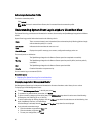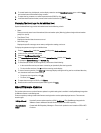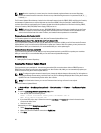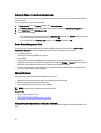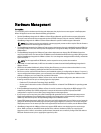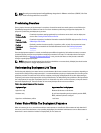
5
Hardware Management
Prerequisites:
To successfully perform hardware provisioning and deployment, the physical servers must appear in the Deployment
Wizard. All physical servers must meet the following prerequisites:
• See the
OpenManage Integration for VMware vCenter Release Notes
for specific hardware support information.
• The server must have the minimum supported versions of iDRAC firmware, Lifecycle controller and BIOS. See the
OpenManage Integration for VMware vCenter Release Notes
for specific hardware support information.
NOTE: If the firmware versions are outdated, a two step upgrade process could be required. See the firmware
documentation for detailed upgrade instructions.
• The OpenManage Integration for VMware vCenter supports deployment using only embedded/integrated LOMs. You
can configure NICs in PCI slots manually after the deployment. If using add-on NICs, the system must have the host
LOMs enabled.
• The OpenManage Integration for VMware vCenter allows deployment onto Internal Dual SD Module (hypervisor
only) or local hard drives. The Internal Dual SD Module must be enabled from BIOS before you deploy the hypervisor
with the OpenManage Integration for VMware vCenter. You can change the management NIC manually, and add the
system to vCenter.
NOTE: For the supported Dual SD Module, see the respective server product documentation.
• If the iDRAC is in dedicated mode, its NIC must be enabled to communicate with the OpenManage Integration for
VMware vCenter.
• CSIOR must be enabled. Additionally, before initiating Auto Discovery, to make sure that retrieved data is current,
the system must be completely powered off and then back on (hard reboot).
• Dell servers can be ordered with Auto Discovery and handshake options pre-configured by the factory. If a server is
not pre-configured with these options, you must manually enter the OpenManage Integration for VMware vCenter IP
address or configure your local network to provide this information.
• If the OpenManage Integration for VMware vCenter is not used for hardware configuration, then make sure the
following conditions are met prior to initiating hypervisor deployment:
– Enable the VT (Virtualization Technology) flag in the BIOS.
– Set the system's boot order to either a bootable Virtual Disk or an Internal Dual SD Module for operating system
installation.
• If the OpenManage Integration for VMware vCenter is used for hardware configuration, the BIOS setting for VT is
automatically enabled, even if BIOS configuration is not part of the hardware profile. Express/Clone RAID
configuration is required if a virtual disk is not already present on the target system.
• If your servers are from versions prior to Dell PowerEdge 12th generation servers, then the deployment process
installs the OpenManage Server Administrator package on the target system, and automatically configures the
SNMP trap destination to point to the OpenManage Integration for VMware vCenter.
• Custom ESXi images that contain
all
the Dell drivers are required for deployment. You can find the correct images by
going to the Dell Drivers & Downloads page and saving the custom images to a location you can access during the
deployment process. For the most up-to date list of supported ESXi versions for this release, see the Release Notes.
•
OpenManage Integration for VMware vCenter
only supports BIOS mode to auto-deploy hypervisor on the target
server. Make sure that you have BIOS mode selected in the reference hardware profile prior to applying the
Hypervisor profile. If there is no hardware profile selected, then make sure to manually configure the boot mode as
BIOS and reboot the server prior to applying the hypervisor profile.
54



